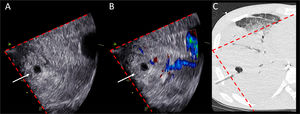Lung ultrasound was used to monitor a patient admitted to ICU for acute respiratory distress syndrome secondary to Influenza A, requiring mechanical ventilation and veno-venous extra-corporeal membrane oxygenation for refractory hypoxemia. ICU stay was complicated by a Staphylococcus aureus ventilator-associated pneumonia. Figure 1: Panel A shows a small anechoic round image (white arrow) within a tissue-like pattern, compatible with both a pulmonary vessel in short axis and a lung abscess within a consolidated parenchyma (Video 1). A second larger anechoic round image is visualized in deeper fields. Color Doppler (Panel B) easily allows distinguishing abscess as non-pulsatile structures (Video 2). On the corresponding CT scan (Panel C), the red dotted lines delineate the ultrasound beam. Ultrasound well identifies lung abscesses within consolidations as round well-defined anechoic images with posterior enhancement and no pulsatility at colour Doppler; this simple bedside application avoids the need of traditional radiology and allows dynamic guidance to procedures, as needle aspiration.
The Impact Factor measures the average number of citations received in a particular year by papers published in the journal during the two preceding years.
© Clarivate Analytics, Journal Citation Reports 2025
SRJ is a prestige metric based on the idea that not all citations are the same. SJR uses a similar algorithm as the Google page rank; it provides a quantitative and qualitative measure of the journal's impact.
See moreSNIP measures contextual citation impact by wighting citations based on the total number of citations in a subject field.
See more






